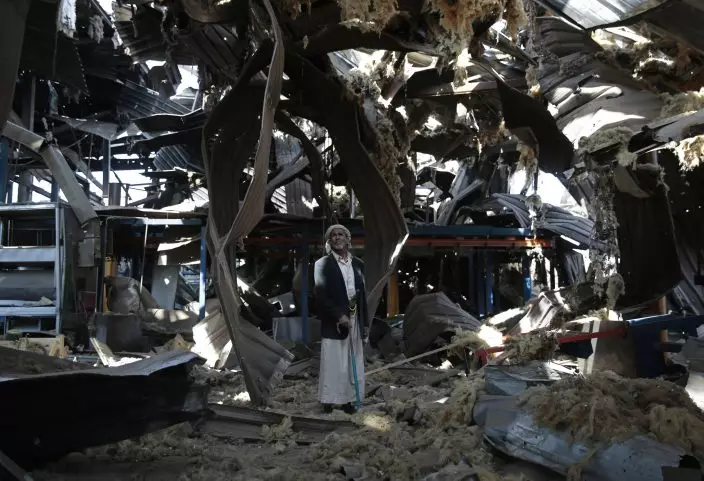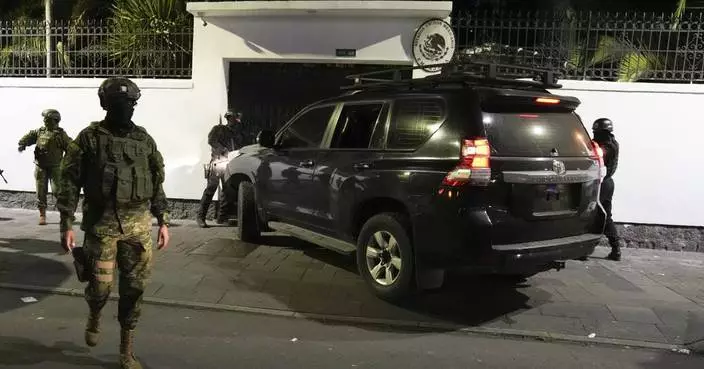The U.N. envoy for Yemen announced Friday the country's internationally recognized government and rival Houthi Shiite rebels have agreed to attend talks aimed at ending their three-year war, which has created the globe's worst humanitarian crisis by pushing the Arab world's poorest country to the brink of famine.
Martin Griffiths told the U.N. Security Council that he planned to bring the warring parties together "soon" in Sweden. He also said the Houthis and the government, which is backed by a Saudi-led coalition, were about to conclude an agreement on exchanging prisoners and detainees.
The spotlight has fallen on what many viewed as the long forgotten war in Yemen since the murder of Saudi journalist Jamal Khashoggi at Saudi Arabia's consulate in Istanbul on Oct. 2. Griffiths said he is determined to take advantage of "the international attention and energy" to move toward peace.

FILE - In this Aug. 13, 2018 file photo, Yemenis attend the funeral of victims of a Saudi-led airstrike, in Saada, Yemen. Airstrikes by Saudi Arabia and its allies in Yemen are on a pace to kill more civilians in 2018 than last year despite US claims that the coalition is working to prevent such bloodshed, a database tracking violence shows. The war, nearly four years old, may have killed as many as 80,000 people, according to the figures, not counting the untold numbers who have died of hunger in the humanitarian disaster wreaked by the conflict. (AP PhotoHani Mohammed, File)
"We must seize this positive international momentum on Yemen," he told the U.N.'s most powerful body. "This is an opportunity at a crucial moment to pursue a comprehensive and inclusive political settlement to the conflict."
Griffiths said preparatory issues for the meeting are close to being resolved and he has sent the parties his "vision" for "U.N.-led, inclusive Yemeni negotiations to end the war and restart a political transition process."
The conflict in Yemen began with the 2014 takeover of the capital of Sanaa by the Iranian-backed Houthis, which toppled the government of Abed Rabbo Mansour Hadi. The Saudi-led coalition allied with the government has been fighting the Houthis since 2015.

FILE - In this Sept. 22, 2016, file photo, a man stands among the rubble of the Alsonidar Group's water pump and pipe factory after it was hit by Saudi-led airstrikes in Sanaa, Yemen. The Saudi-led coalition fighting in Yemen said early Saturday, Nov. 10, 2018, it had "requested cessation of inflight refueling" by the U.S. for its fighter jets after American officials said they would stop the operations amid growing anger over civilian casualties from the kingdom's airstrikes. (AP PhotoHani Mohammed, File)
Saudi-led airstrikes have hit schools, hospitals and wedding parties and killed thousands of Yemeni civilians. The Houthis have fired long-range missiles into Saudi Arabia and targeted vessels in the Red Sea.
Civilians have borne the brunt of the conflict, which has killed over 10,000 people and created what the executive director of the U.N.'s World Food Program said Friday is "a catastrophe."
David Beasley, who just returned from a three-day visit to Yemen, told the Security Council that "we do not need to wait for formal declarations about famine or even a full report to act."

FILE - In this Oct. 14, 2016 file photo, fire and smoke rise after a Saudi-led airstrike hit a site believed to be one of the largest weapons depots on the outskirts of Yemen's capital, Sanaa. Airstrikes by Saudi Arabia and its allies in Yemen are on a pace to kill more civilians in 2018 than last year despite US claims that the coalition is working to prevent such bloodshed, a database tracking violence shows. The war, nearly four years old, may have killed as many as 80,000 people, according to the figures, not counting the untold numbers who have died of hunger in the humanitarian disaster wreaked by the conflict. (AP PhotoHani Mohammed, File)
"I believe that because of what I saw and heard this week children are already dying," he said.
Beasley warned that "starvation is on the horizon unless circumstances change — and change immediately."
Right now, he said, his agency is helping about 8 million people a month in Yemen but the situation has become "extremely dire."
"Of the 28 million Yemenis, we believe that as many as 12 million or more Yemenis — yes, that's right, almost half of the entire country — are just one step away from famine," Beasley said.
That number has doubled in the last year and a half and the situation is getting even worse, largely because of the collapse of Yemen's economy and the sharp decline in its currency, he said.
To avert famine, Beasley said, the international community must combine increased humanitarian funding with "an all-out effort to restore the Yemeni economy."
He said that will require scaling up assistance to help 12 million Yemenis, which would require about $150 million to $160 million a month. And it would require a cash injection of $200 million a month into Yemen's economy to stabilize its currency and stave off economic collapse, he said.
"Yemen is on the brink — so together we must act," Beasley said. Otherwise, he warned, "we will be in the position of deciding which children live and which children die."
U.N. humanitarian chief Mark Lowcock, who warned the council on Oct. 23 that the economic crisis and escalating conflict had pushed Yemen closer to famine than ever before, also urged its members to take action now.
In addition to also urging the parties to negotiate an end to the conflict and the international community to boost aid, he called for a humanitarian cease-fire around key aid facilities, delivery of humanitarian and commercial imports to all Yemeni ports and onward to their final destinations, and funding to pay Yemeni pensioners and civil servants.
Britain's U.N. ambassador, Karen Pierce, said she will circulate a Security Council resolution Monday to address the Yemen crisis and put Lowcock's requests "into practice."
U.S. deputy ambassador Jonathan Cohen told the council: "This war must end soon, and it won't end on the battlefield." He reiterated U.S. Secretary of State Mike Pompeo's words: "The United States seeks a cessation of hostilities in Yemen."
Lowcock noted that after an upsurge in fighting immediately after his Oct. 23 briefing to the council, there has been "a welcome de-escalation" in the last two days.
"But what we need to know is that this lull is going to be sustained," Lowcock said. "It remains urgent for the parties to agree a cessation of hostilities."












